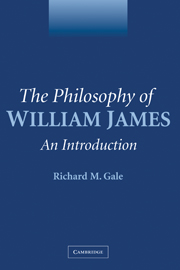Book contents
- Frontmatter
- Contents
- Preface
- Introduction
- PART I THE PROMETHEAN PRAGMATIST
- 1 The Ethics of Prometheanism
- 2 The Willfulness of Belief
- 3 The Freedom of Belief
- 4 The Will to Believe
- 5 The Ethics of Truth
- 6 The Semantics of “Truth”
- 7 Ontological Relativism: William James Meets Poo-bah
- PART II THE PASSIVE MYSTIC
- Bibliography of Works Cited
- Suggested Further Readings
- Index
6 - The Semantics of “Truth”
Published online by Cambridge University Press: 06 January 2010
- Frontmatter
- Contents
- Preface
- Introduction
- PART I THE PROMETHEAN PRAGMATIST
- 1 The Ethics of Prometheanism
- 2 The Willfulness of Belief
- 3 The Freedom of Belief
- 4 The Will to Believe
- 5 The Ethics of Truth
- 6 The Semantics of “Truth”
- 7 Ontological Relativism: William James Meets Poo-bah
- PART II THE PASSIVE MYSTIC
- Bibliography of Works Cited
- Suggested Further Readings
- Index
Summary
James was interpreted in the previous chapter as giving a morally based revisionary analysis of belief acceptance and truth that held us to be morally obligated to believe in a way that maximizes desire–satisfaction, with the result that a proposition counts as true when believing it maximizes desire–satisfaction. He supplemented this account with guiding principles enjoining us to have beliefs that are both consistent and epistemically warranted, and to follow a conservative strategy when it becomes necessary to revise our web of belief, which really was a web of mentation since it included conative states and emotions along with beliefs. It was suggested that things would go best if James went with a web comprised exclusively of beliefs. Because the rationale for accepting these guiding principles is to help us maximize desire–satisfaction in the long run, they admit of exceptions when doing so on some occasion can achieve this. Thus, they are merely instrumental rules.
James motivated his revisionary analysis by both therapeutic and moral considerations. By accepting his moralizing of epistemology we avoid commitment to the empirically vacuous truth or correspondence relation of common sense, with all of the mental cramps and perplexities that this occasions, which, in turn, aids our promethean endeavor to achieve our summum bonum, that being the full self-realization for each of our many selves.
- Type
- Chapter
- Information
- The Philosophy of William JamesAn Introduction, pp. 112 - 131Publisher: Cambridge University PressPrint publication year: 2004

